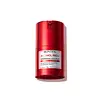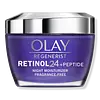What's inside
What's inside
 Key Ingredients
Key Ingredients

 Benefits
Benefits

 Concerns
Concerns

 Ingredients Side-by-side
Ingredients Side-by-side

Water
Skin ConditioningButylene Glycol
HumectantGlycerin
HumectantDimethicone
EmollientPentylene Glycol
Skin ConditioningSqualane
EmollientNiacinamide
SmoothingIsononyl Isononanoate
EmollientC12-20 Acid PEG-8 Ester
EmulsifyingNylon-12
Cetyl Alcohol
Emollient1,2-Hexanediol
Skin ConditioningPEG-100 Stearate
Hydroxyacetophenone
AntioxidantHydroxyethylpiperazine Ethane Sulfonic Acid
BufferingAmmonium Acryloyldimethyltaurate/Beheneth-25 Methacrylate Crosspolymer
Emulsion StabilisingSodium Polyacryloyldimethyl Taurate
Emulsion StabilisingAdenosine
Skin ConditioningHydroxydecyl Ubiquinone
AntioxidantRetinyl Palmitate
Skin ConditioningTocopherol
AntioxidantPotassium Cetyl Phosphate
EmulsifyingPolysorbate 20
EmulsifyingRetinol
Skin ConditioningHydrogenated Polydecene
EmollientSophora Flavescens Root Extract
AntioxidantCoco-Glucoside
CleansingHydroxypropyl Cyclodextrin
MaskingTribulus Terrestris Fruit Extract
Skin ConditioningPentaerythrityl Tetra-Di-T-Butyl Hydroxyhydrocinnamate
AntioxidantDipropylene Glycol
HumectantCornus Officinalis Fruit Extract
Skin ConditioningFullerenes
AntimicrobialCopper Tripeptide-1
Skin ConditioningHydrolyzed Sodium Hyaluronate
Skin ConditioningPinus Densiflora Leaf Extract
AntimicrobialDisodium EDTA
Trideceth-10
CleansingSodium Hyaluronate
HumectantLactobacillus Ferment
Skin ConditioningBHT
AntioxidantQuaternium-73
BHA
AntioxidantTetrapeptide-4
Skin ConditioningPalmitoyl Tripeptide-8
Skin ConditioningPhytol
EmollientArginine/Lysine Polypeptide
Skin ConditioningPvp
Emulsion StabilisingWater, Butylene Glycol, Glycerin, Dimethicone, Pentylene Glycol, Squalane, Niacinamide, Isononyl Isononanoate, C12-20 Acid PEG-8 Ester, Nylon-12, Cetyl Alcohol, 1,2-Hexanediol, PEG-100 Stearate, Hydroxyacetophenone, Hydroxyethylpiperazine Ethane Sulfonic Acid, Ammonium Acryloyldimethyltaurate/Beheneth-25 Methacrylate Crosspolymer, Sodium Polyacryloyldimethyl Taurate, Adenosine, Hydroxydecyl Ubiquinone, Retinyl Palmitate, Tocopherol, Potassium Cetyl Phosphate, Polysorbate 20, Retinol, Hydrogenated Polydecene, Sophora Flavescens Root Extract, Coco-Glucoside, Hydroxypropyl Cyclodextrin, Tribulus Terrestris Fruit Extract, Pentaerythrityl Tetra-Di-T-Butyl Hydroxyhydrocinnamate, Dipropylene Glycol, Cornus Officinalis Fruit Extract, Fullerenes, Copper Tripeptide-1, Hydrolyzed Sodium Hyaluronate, Pinus Densiflora Leaf Extract, Disodium EDTA, Trideceth-10, Sodium Hyaluronate, Lactobacillus Ferment, BHT, Quaternium-73, BHA, Tetrapeptide-4, Palmitoyl Tripeptide-8, Phytol, Arginine/Lysine Polypeptide, Pvp
Water
Skin ConditioningDimethicone
EmollientGlycerin
HumectantTapioca Starch
Dimethicone Crosspolymer
Emulsion StabilisingRetinol
Skin ConditioningRetinyl Propionate
Skin ConditioningNiacinamide
SmoothingPalmitoyl Pentapeptide-4
Skin ConditioningPolyacrylamide
C13-14 Isoparaffin
EmollientDMDM Hydantoin
PreservativePolysorbate 20
EmulsifyingLaureth-4
EmulsifyingAcrylates/C10-30 Alkyl Acrylate Crosspolymer
Emulsion StabilisingLaureth-7
EmulsifyingDimethiconol
EmollientPolymethylsilsesquioxane
Aminomethyl Propanol
BufferingTitanium Dioxide
Cosmetic ColorantDisodium EDTA
Iodopropynyl Butylcarbamate
PreservativeAminopeptidase
Skin ConditioningWater, Dimethicone, Glycerin, Tapioca Starch, Dimethicone Crosspolymer, Retinol, Retinyl Propionate, Niacinamide, Palmitoyl Pentapeptide-4, Polyacrylamide, C13-14 Isoparaffin, DMDM Hydantoin, Polysorbate 20, Laureth-4, Acrylates/C10-30 Alkyl Acrylate Crosspolymer, Laureth-7, Dimethiconol, Polymethylsilsesquioxane, Aminomethyl Propanol, Titanium Dioxide, Disodium EDTA, Iodopropynyl Butylcarbamate, Aminopeptidase
Ingredients Explained
These ingredients are found in both products.
Ingredients higher up in an ingredient list are typically present in a larger amount.
Dimethicone is a type of synthetic silicone created from natural materials such as quartz.
What it does:
Dimethicone comes in different viscosities:
Depending on the viscosity, dimethicone has different properties.
Ingredients lists don't always show which type is used, so we recommend reaching out to the brand if you have questions about the viscosity.
This ingredient is unlikely to cause irritation because it does not get absorbed into skin. However, people with silicone allergies should be careful about using this ingredient.
Note: Dimethicone may contribute to pilling. This is because it is not oil or water soluble, so pilling may occur when layered with products. When mixed with heavy oils in a formula, the outcome is also quite greasy.
Learn more about DimethiconeDisodium EDTA plays a role in making products more stable by aiding other preservatives.
It is a chelating agent, meaning it neutralizes metal ions that may be found in a product.
Disodium EDTA is a salt of edetic acid and is found to be safe in cosmetic ingredients.
Learn more about Disodium EDTAGlycerin is already naturally found in your skin. It helps moisturize and protect your skin.
A study from 2016 found glycerin to be more effective as a humectant than AHAs and hyaluronic acid.
As a humectant, it helps the skin stay hydrated by pulling moisture to your skin. The low molecular weight of glycerin allows it to pull moisture into the deeper layers of your skin.
Hydrated skin improves your skin barrier; Your skin barrier helps protect against irritants and bacteria.
Glycerin has also been found to have antimicrobial and antiviral properties. Due to these properties, glycerin is often used in wound and burn treatments.
In cosmetics, glycerin is usually derived from plants such as soybean or palm. However, it can also be sourced from animals, such as tallow or animal fat.
This ingredient is organic, colorless, odorless, and non-toxic.
Glycerin is the name for this ingredient in American English. British English uses Glycerol/Glycerine.
Learn more about GlycerinNiacinamide is a multitasking form of vitamin B3 that strengthens the skin barrier, reduces pores and dark spots, regulates oil, and improves signs of aging.
And the best part? It's gentle and well-tolerated by most skin types, including sensitive and reactive skin.
You might have heard of "niacin flush", or the reddening of skin that causes itchiness. Niacinamide has not been found to cause this.
In very rare cases, some individuals may not be able to tolerate niacinamide at all or experience an allergic reaction to it.
If you are experiencing flaking, irritation, and dryness with this ingredient, be sure to double check all your products as this ingredient can be found in all categories of skincare.
When incorporating niacinamide into your routine, look out for concentration amounts. Typically, 5% niacinamide provides benefits such as fading dark spots. However, if you have sensitive skin, it is better to begin with a smaller concentration.
When you apply niacinamide to your skin, your body converts it into nicotinamide adenine dinucleotide (NAD). NAD is an essential coenzyme that is already found in your cells as "fuel" and powers countless biological processes.
In your skin, NAD helps repair cell damage, produce new healthy cells, support collagen production, strengthen the skin barrier, and fight environmental stressors (like UV and pollution).
Our natural NAD levels start to decline with age, leading to slower skin repair, visible aging, and a weaker skin barrier. By providing your skin niacinamide, you're recharging your skin's NAD levels. This leads to stronger, healthier, and younger looking skin.
Another name for vitamin B3 is nicotinamide. This vitamin is water-soluble and our bodies don't store it. We obtain Vitamin B3 from either food or skincare. Meat, fish, wheat, yeast, and leafy greens contain vitamin B3.
The type of niacinamide used in skincare is synthetically created.
Learn more about NiacinamidePolysorbate 20 is made by combining ethoxylation of sorbitan, ethylene oxide, and lauric acid. It is a mild cleansing agent, surfactant, and emulsifier.
As a surfactant, it helps collect dirt and oils for washing. Emulsifiers prevent oils and water from separating.
Polysorbate 20 also adds scent to a product. Since it is made using sorbitol, it has a sweet scent. Sorbitol can also be found in fruits such as apples and peaches.
The lauric acid used to create Polysorbate 20 is often derived from coconuts.
Polysorbate 20 may not be fungal acne safe.
Learn more about Polysorbate 20Retinol is a gold-standard ingredient for anti-aging. It is a form of Vitamin A and belongs to the class of retinoids that also includes tretinoin.
Why is retinol famous?
It has the most scientific studies backing up its skin benefits out of all the non-prescription ingredients.
Retinol is proven to:
This is why retinol is effective at removing wrinkles, fading dark spots, treating acne, and reducing the appearance of pores.
Studies show retinol is less effective when exposed to UV. Be sure to look for appropriate packaging to keep your retinol potent (similar to Vitamin C).
Using retinol or any retinoids will increase sun-sensitivity in the first few months. Though studies show retinoids increase your skin's natural SPF with continuous use, it is best to always wear sunscreen and sun-protection.
We recommend speaking with a medical professional about using this ingredient during pregnancy.
Retinol may cause irritation in some people, so be sure to patch test. Experts recommend 'ramping up' retinol use: start using this ingredient once a week and work up to using it daily.
Read about Tretinoin
Learn more about RetinolWater. It's the most common cosmetic ingredient of all. You'll usually see it at the top of ingredient lists, meaning that it makes up the largest part of the product.
So why is it so popular? Water most often acts as a solvent - this means that it helps dissolve other ingredients into the formulation.
You'll also recognize water as that liquid we all need to stay alive. If you see this, drink a glass of water. Stay hydrated!
Learn more about Water